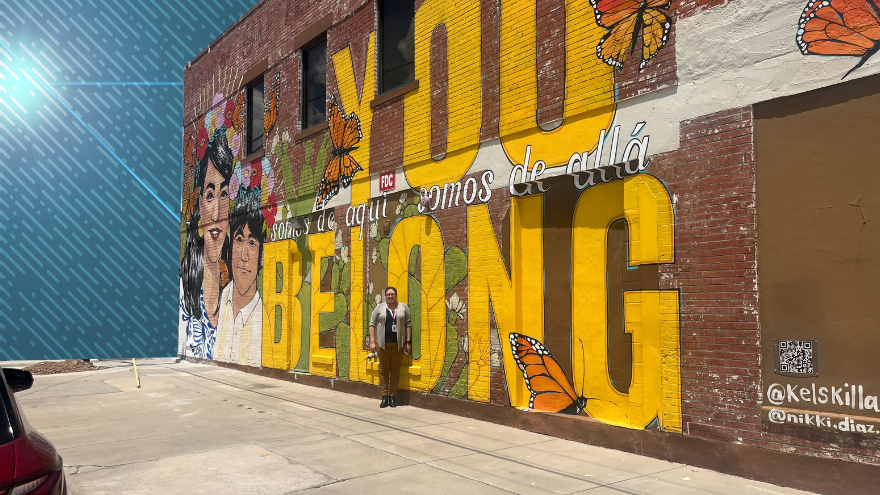EL PASO, Texas – New video has emerged showing that while thousands of migrants are no longer lining local streets in homeless encampments, thousands are being crowded into detainment facilities designed to operate at a fraction of their current capacity.
Texas Rep. Tony Gonzales released footage recorded while he visited the Border Patrol’s Central Processing Center, which has a maximum capacity of 1,000 detainees, but held 6,000 detainees the day the footage was shot.
In the video, viewers can see roughly 750 people packed into a room designed to hold just 120, highlighting the inhumane conditions that asylum seekers are enduring while waiting to be processed.
U.S. officials are now building new facilities and devising ways to better handle the surge at the nation’s southern border, while advocates for immigrants and illegal aliens seeking to become fully naturalized U.S. citizens point to a broken system, as they fight for change.
Imelda Maynard, Legal Director for Diocesan Migrant & Refugee Services, Inc. (DMRS), says that a good way to begin revamping the cumbersome U.S. immigration system would be to expand the guest worker VISA program instead of forcing people seeking asylum to wait excessively long times to become legalized.
“People are already here. They’re coming here to work. Just give them work permits and let them work here and establish that as a path to legal residency instead of having to go through all of this red tape,” she told Timcast News in an interview at the organization’s El Paso office.
“Because — what’s gonna end up happening is — you’re gonna have all these people coming to seek asylum. And our asylum laws are pretty Draconian, and so you’re going to have a lot of people that by the time they get to court – some of these folks are getting to court in like three or four years – they’ve already established lives here,” she explained. “And so you’re thinking that when the judge says, ‘Sorry, you have to go back,’ that that’s gonna be an easy thing. It’s not.”
Maynard says that congress could smooth the pathway for legalization by vetting asylum seekers from abroad the same way the U.S. government currently does, but rather than the end point being asylum, it could be the work permit.
DMRS is a ministry of the Catholic Diocese of El Paso, and is the largest legal service provider in West Texas and New Mexico. The organization handles both affirmative and defensive immigration proceedings, working with individuals who want to normalize (legalize) their status in the U.S. DMRS is also the legal service provider for all of the unaccompanied minor shelters in El Paso. Maynard says they are experiencing high volumes of children with no parent or guardian who have made the journey to the U.S. alone.
“That’s always been sort of steady, and that’s been a byproduct of Title 42. So because Title 42 had not applied to children or unaccompanied minors, what ended up happening is, when families weren’t able to get through, the entire family unit would be turned around under Title 42,” she said. “Families were making the tough decision of saying, ‘Well, you know, as a mother, I can’t go with my kids, but I want my kids to have a better life.’ And so they’d send the kids by themselves, so then the children would be processed as unaccompanied minors. And that’s why we have so many unaccompanied children.”
The Double-Edged Sword of Human Smuggling Networks
Depending on the point of origin, migrants may travel through half a dozen countries or more before they reach the U.S. southern border with Mexico.
The need to navigate these different countries and hazardous terrain as safely as possible is the reason some families choose to hire smugglers, often referred to as coyotes, Maynard said. Those who can’t are often “prey to everyone in sight,” including cartel members, corrupt federal police officers, and “just about anyone along the way.”
She added, “It’s unfortunately very common to hear those kinds of stories.” So, in essence, human smugglers can be a type of bodyguard for migrants and unaccompanied minors.
Officials at the U.S. Immigration and Customs Enforcement (ICE) have previously stated that “an understanding exists among transnational criminal organizations, smugglers and individuals seeking transport that trying to cross the border independently is not an option.” The agency added that though smugglers may use legitimate means of transportation, like buses and flights, many “move humans as part of cargo transports, in vehicles, in boats, in tractor-trailers, in box cars on trains and in automobiles and trucks that are transported on trains as cargo” — with little regard for the comfort and safety of the people they are moving.
Describing the danger facing unaccompanied minors traveling through multiple countries, Maynard noted it is important to remember that each country has its own laws and immigration systems. “And so people are not just entering the U.S. irregularly,” she explained, “they’re entering Mexico irregularly, right? Or going through the Darién Gap” — a geographic region in the Isthmus of Panama that connects North and South America.
The smuggling system is pay-to-play, she stated. So, the money doesn’t just go to a smuggler, it goes to their entire network, which allows a traveler to get through various tightly-controlled zones migrants must use to make it to the U.S. Oftentimes, when using a smuggling network for protection, migrants are given specific codes to give certain individuals along the way in order to continue their journey.
Nevertheless, illicit human smuggling services carry their own grave risks and the trek from Central or South America to the U.S. border is fraught with peril.
Video surfaced in 2021 showing Mexican smugglers bringing drugged and sedated children across the U.S. southern border. During that same year, the U.S. Customs and Border Protection (CBP) released footage of smugglers dropping two Ecuadorian toddlers from the top of the 14-foot-high wall that divides the U.S. and Mexico. The three-year-old and five-year-old Ecuadoran children were abandoned by their coyotes and attended to by CBP agents.
In March 2023, Mexican authorities discovered 343 migrants, including 103 unaccompanied minors, in an abandoned trailer on a highway in Veracruz. Though they all survived, the previous year 50 migrants were found dead in a tractor trailer in San Antonio.
Even making it into the U.S. does not guarantee complete safety. Less than a week ago, a 17-year-old migrant from Honduras died in custody in a Florida facility that was sheltering unaccompanied minors for the Department of Health and Human Services’ Office of Refugee Resettlement.
But, DMRS and El Paso’s local religious community have tasked themselves with the mission of doing all they can to provide assistance and safety by extending relief once migrants have entered the U.S.
Local Community Impact
El Paso is situated across the Rio Grande adjacent to the Mexican city of Juarez, which is home to an estimated 2.5 million people. Shortly before the end of Title 42, thousands of migrants flocked to the U.S. southern border, many waiting in and around Juarez for a chance to make it to El Paso to file an asylum claim and enter the U.S.
Preparing for the influx of migrants, and wanting to make good on a core tenet of Christianity to “love thy neighbor as thyself,” the Catholic Diocese of El Paso opened shelters to house and support those who had endured the arduous expedition.
On the evening of May 15, the Diocese held a prayer service at St. Patrick’s Cathedral. Though dozens of people were expected, hundreds showed up to offer prayers and support for the shelter’s staff and the migrants they would be assisting.
The church already had three shelters in operation, but amid the latest migrant surge opened two more, bringing the total to five, Bishop Mark Seitz told Timcast News in an interview following the service.
Prior to the latest surge, the El Paso’s Catholic Diocese was helping more than 300 migrants per day. “There was a rush to get in before Title 42 ended, thinking that the consequences were going to be less severe,” Seitz said.
Just days before Title 42 ended, U.S. authorities announced they would be stepping up enforcement measures – including possible deportations – and urged migrants on the streets of El Paso to turn themselves in for processing, which many did. Since that time last week, Border Patrol facilities have remained overrun. But, as migrants are processed and released, many will be forced to look for other accommodations as they figure out their next steps. Sietz said the Diocese is expecting a wave of people coming to their shelters, as many won’t be able to simply leave town immediately.
During the prayer service, Seitz petitioned the congregation to embrace God’s love in caring for migrants seeking help. Critics may object to the Diocese’s position, stressing that God is also a God of justice, while arguing that the church should be urging illegal aliens not to storm U.S. border, but to go through the legal means of obtaining citizenship.
Seitz responded to such criticism, saying, “First of all, justice is not defined by our laws, which are human laws, and there are better laws to the degree they correspond to God’s justice. Secondly, I’d point out that those who say that really don’t understand why the vast majority of people are coming and under what circumstances.”
He continued: “We just don’t have an experience that allows us to really identify with a situation where people live in fear every moment of their life; and where the organized crime is stronger than the government in some places; and where the government is completely repressive, such as in Venezuela and Nicaragua and Cuba right now. We just can’t even imagine that.”
Venezuela is currently experiencing political, economic, and humanitarian crises. Nicaragua has seen political prisoners tortured, and hundreds of activists, human rights defenders, and journalists forced to flee in exile. Cuba’s regime just closed out April with more than 1,000 political prisoners in jail.
“If we were in their situation, we would have no qualms about picking up and running even if at risk of our life because we would say, ‘Okay, I have a choice between certain death and the possibility that I might find a new life,'” he added.
“And we human beings are people of hope. They’re gonna take that chance no matter how difficult it is,” Seitz declared. “So, you know, you wouldn’t ask questions about whether they should sit around and think about it for a while, or apply and wait for six months if the gang is saying, ‘We want your daughter, we want your son.’ We’d get out of there.”
Seitz says it can be challenging to help people on a more long-term basis because people pass through the shelters so quickly. But the church is able to provide “a smile, some clean clothes, and the chance to take a shower and have some good food,” he said.
And while the Diocese can’t give them money for travel, they are able to help migrants connect with their families.
The U.S. immigration system is a colossal beast with a dizzying number of moving pieces. It can be draining on everyone, from those seeking asylum, to people evicted from their own shelters to make room for migrants, and especially those on the frontlines tasked with stopping illegal entry into the country.
But, despite the headaches and suffering that this issue often brings, the local religious community in El Paso has carved out a small niche where they can make a big impact.

